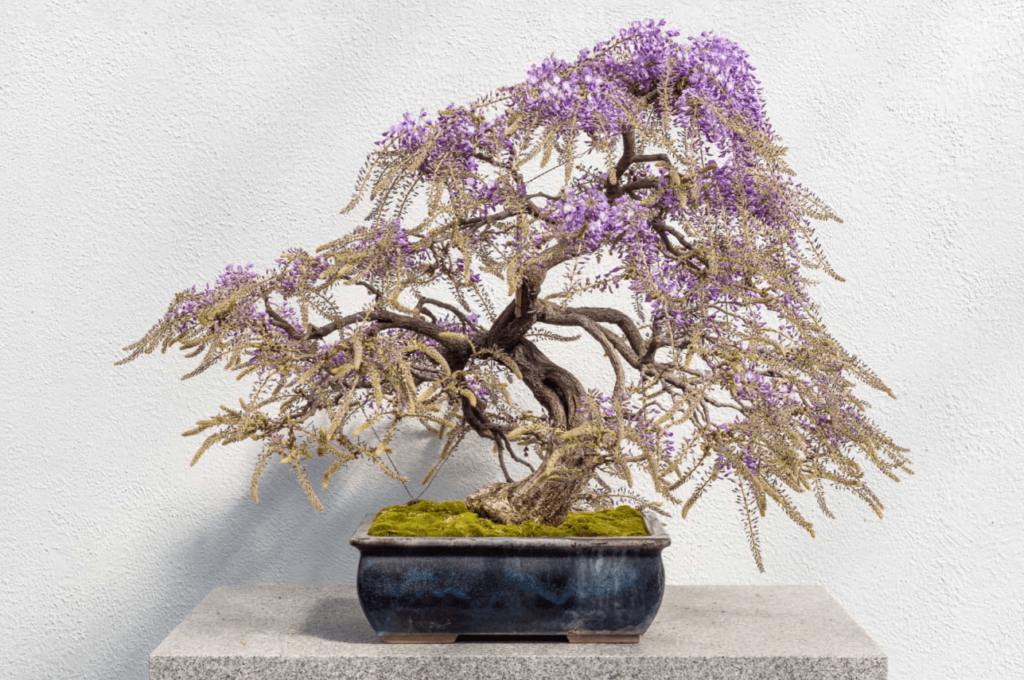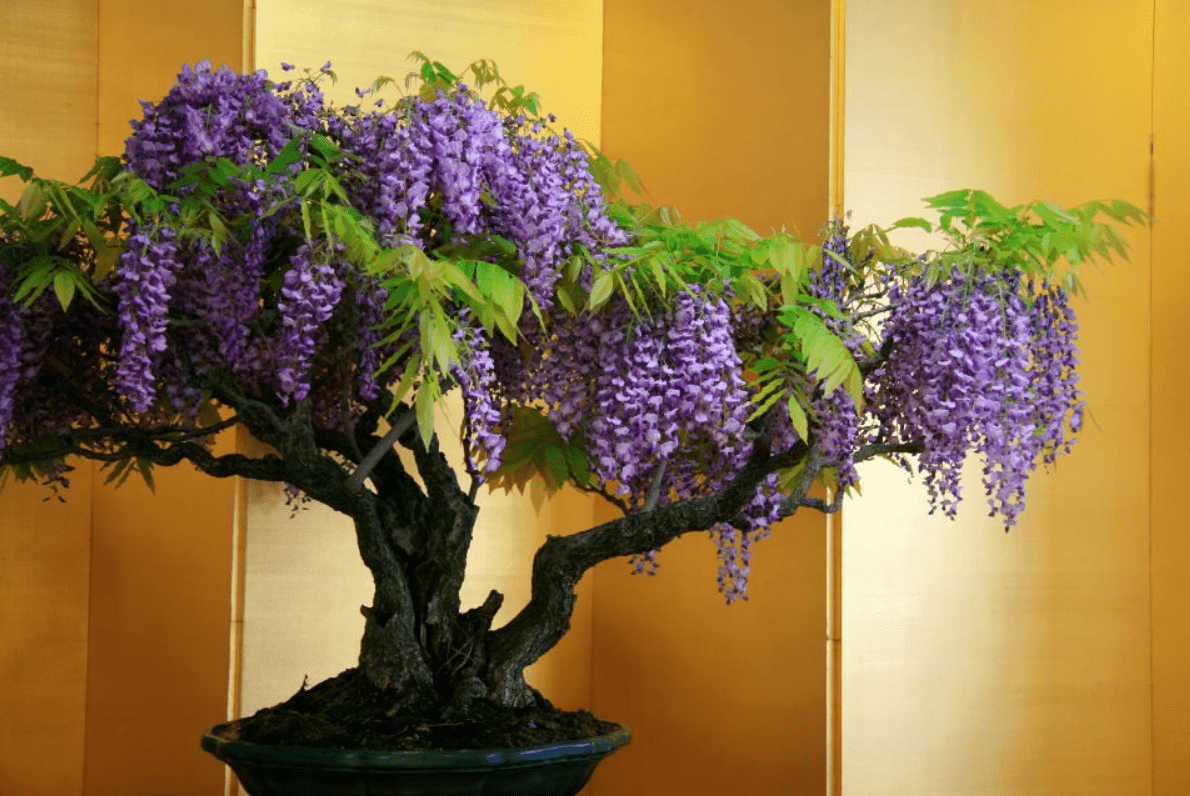Wisteria Bonsai Bonsai these miniature masterpieces combine artistic expression and horticultural techniques to captivate viewers’ attention. In this article, we will explore the mesmerizing charms of Wisteria Bonsai Bonsai. Explore the history, care and cultivation of this incredible living work of art. Wisteria Bonsai Bonsai is native to the east and has a centuries-old cultural heritage. Smaller, larger replicas of bonsai are considered a wonderful symbol of harmony between man and nature. They are carefully crafted and refined over time. When you delve deeper into the wisteria bonsai You will learn about the complicated process of growing a wisteria bonsai. Growing wisteria bonsai requires unwavering dedication and meticulous attention to detail. From selecting the perfect seedling to learning precise pruning and training techniques, here you go!
Table of Contents
Wisteria Bonsai Bonsai Tree Facts

| Botanical Name | Wisteria floribunda, Wisteria sinensis, among others |
| Popular Options | Alba, Domino, Lawrence, Macrobotrys |
| Sunlight | Full sun or partial shade |
| Soil | Chalky, loamy soil that drains well |
| Water | Once a week |
| For Beginners? | Yes |
| Indoors or Outdoors? | Both |
| Pairs Well With… | Clematis, Any climbing vine |
Common Types of Wisteria Bonsai Bonsai Trees
A beautiful and popular ornamental plant. Wisteria Bonsai Bonsai brings elegance and beauty to any garden or living space. Wisteria’s beautiful vines and lively cascading flowers make it a popular choice among bonsai enthusiasts. There are many types and varieties of wisteria bonsai. Each has special properties that make these little wonders unique and charming.
Chinese Wisteria (Wisteria Sinensis)
One of the most widely grown types of bonsai is the Chinese wisteria. Famous for its stunning appearance and fast growth. This plant has lavender flowers. blue or white flowers Housed in long inflorescences, the small, delicate leaves make up the foliage and provide a beautiful backdrop for flower arrangements. Chinese Wisteria Bonsai Bonsai requires frequent care and pruning to maintain its ideal shape. But the stunning flowers are worth the effort.
Japanese Wisteria (Wisteria Floribunda)
Another popular choice among bonsai enthusiasts is Japanese wisteria, which has long, drooping flowers. Wisteria comes in charming shades of purple, blue, pink and white. Wisteria is an interesting subject for bonsai techniques. Because of its unique flowers and strong branches To maintain the health and strength of wisteria at the same time with achieving the desired artistic style This variety must be carefully trimmed and rewired.
American Wisteria (Wisteria Frutescens)
Although American wisteria is not as popular in bonsai culture as its Asian cousin, But it is native to the southeastern United States and is a good choice. With a more compact growth habit and shorter branch size. American wisteria is therefore a good choice for small bonsai projects. The fragrant flowers are usually lavender or pale blue. and helps add fragrance to the surrounding air.
Silky Wisteria (Wisteria Venusta)
The beautiful Silky Wisteria variety is native to China. It is also known as Wisteria venusta or Wisteria brachybotrys. The silvery hairs on new shoots are a distinctive feature of this variety. Makes it look like heaven. Silky wisteria is popular because it blooms easily and is easy to care for. It produces light purple, blue, or white flowers in a short, thick bouquet.
Double-Flowered Wisteria
There are many types and varieties of wisteria. But double-flowered wisteria is a visually beautiful type that produces flowers with many layers of petals. This characteristic of bonsai makes it a spectacular and eye-catching sight when in bloom. These impressive trees are prized by gardeners for their aesthetic value. Because these plants add a beautiful touch to any bonsai collection.
Caring For Your Wisteria Bonsai Tree
Wisteria Bonsai Bonsai is a beautiful plant. It is prized for its blooming flowers and graceful vines. Wisteria requires proper care to maintain its health and attractiveness.
Placement and Sunlight
Wisteria Bonsai Bonsai should be placed in a location that receives adequate sunlight. Wisteria Bonsai Bonsai likes direct sunlight. Therefore, an area that receives at least 6 hours of sunlight per day is best. If you grow bonsai in your home Make sure it gets enough light by placing it next to a south-facing window or under a grow light.
Watering
Water your Wisteria Bonsai Bonsai regularly to keep the soil evenly moist but not wet. To check soil moisture Use your index finger about 1 inch down. If it feels dry, you need to water it. Water gently and don’t disturb the roots or soil.
Pruning
Pruning is important in maintaining Wisteria Bonsai Bonsai. Maintain your bonsai to the desired size and shape by pruning long, new branches frequently. Pruning should be carried out during a dormant period when the plant is not actively growing, such as in late winter or early spring.
Wiring and Training
Creating a Wisteria Bonsai Bonsai requires training and wiring installation. Use a soft copper or aluminum wire to carefully guide the branch to the correct position. Wisteria branches are fragile. So be careful when applying too much pressure, checking often to make sure the cable doesn’t cut branches. and adjust or remove them as necessary.
Fertilizing
To keep your Wisteria Bonsai Bonsai alive and healthy Apply fertilizer during the growing season. Feed with a balanced, water-soluble fertilizer every so often. two to three weeks To allow the tree to rest during the dormant season. Reduce or stop adding fertilizer.
Repotting
Wisteria Bonsai Bonsai should be planted every two to three years to revitalize the soil and prevent the roots from becoming overcrowded. New plantings are most effective in early spring. before new buds appear When newly planted Cut the roots carefully to encourage new growth and maintain a compact root structure.
Pest and Disease Control
Watch out for pests and diseases that can harm your Wisteria Bonsai Bonsai. Aphids, scale insects, and spider mites are common pests. If you encounter a problem Immediately apply insecticidal soap or horticultural oil.
Winter Care
In winter, move your wisteria bonsai to a sheltered location. Or cover the pot with plastic wrap or mulch to protect it from sub-zero weather. You must water carefully during this time. This is because plant growth will slow down.
Pruning Your Wisteria Bonsai Tree
Pruning is an important part of tree care to keep your wisteria bonsai in good condition. Promote good growth and produce abundant flowers Follow these detailed steps to prune your wisteria bonsai tree properly.
1. Choose the Right Time for Pruning
The best time to prune a wisteria bonsai is when it is dormant. This is usually in late winter or early spring. Pruning allows the tree to focus on recovery and new growth when it’s time to plant.
2. Prepare Your Tools
Gather the tools you need to prune your wisteria bonsai. You will need sharp pruning shears or shears to make precise cuts without damaging the branch. To prevent the spread of disease Make sure your tools are clean and disinfected.
3. Identify Dead and Diseased Branches
First, inspect your wisteria bonsai for diseased or dead branches. These branches may appear brittle, discolored or dry and must be removed to maintain the overall health of the plant and prevent the spread of disease.
4. Look for Overcrowded Branches
Then look for overgrown branches that block ventilation or sunlight. Areas with too many dense branches can become infected with fungus and cause a loss of overall structural integrity. Carefully prune these branches to expand the crown.
5. Trim Back Long Shoots
Wisteria is famous for its fast growth. And its long branches can quickly cover the shape of a bonsai. To maintain the wisteria bonsai to the desired size and shape Cut off these long branches, making precise cuts just above the foliage to encourage new growth in the desired direction.
6. Encourage Flowering
If you reduce the number of side branches of the main branch of a wisteria bonsai It will bloom more easily. This step focuses the plant’s energy on the living buds. and increases the number of flowers that plants produce during flowering.
7. Shaping the Canopy
Imagine what shape you want your wisteria bonsai to take, and carefully prune branches to achieve it. Use the “cut and plant” method and let the plant spread naturally. Then cut it back to the desired shape.
8. Regular Maintenance
Pruning is an ongoing step in caring for wisteria bonsai. Check your bonsai often. to view new growth and reshape as needed With regular pruning throughout the year. You can guarantee the long-term health and optimum condition of your wisteria bonsai.
9. Dispose of Pruned Branches Properly
After pruning the wisteria bonsai Dispose of cut branches properly. This will prevent the infection from spreading to other parts of the bonsai. Take the cuttings out of the pot and dispose of them by throwing them away or composting them.
Also Read The Article: Japanese Black Pine Bonsai Tree
